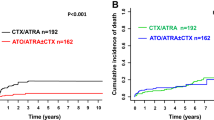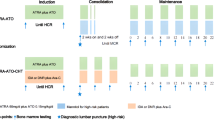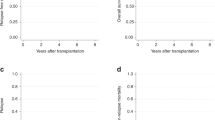Abstract
To determine prognosis of acute promyelocytic leukemia (APL) failing to front-line therapy with all-trans retinoic acid (ATRA) and anthracyclines, outcome of 52 patients (32 M/20 F; age: 37, 3–72) included in PETHEMA trials LPA96 and LPA99 who presented with either molecular failure (MOLrel, n=16) or hematological relapse (HEMrel, n=36) was analyzed. Salvage therapy consisted of ATRA and high-dose ara-C-based chemotherapy (HDAC) in most cases (83%), followed by stem-cell transplantation (autologous, 18; allogeneic, 10; syngeneic, 1). Fourteen patients with MOLrel (88%) achieved second molecular complete response (molCR), whereas 81% HEMrel patients responded to second-line treatment, with 58% molCR. After median follow-up of 45 months, four MOLrel and 18 HEMrel patients, respectively, experienced a second relapse. Outcome after MOLrel compared favorably to HEMrel, with longer survival (5-year survival: 64±14 vs 24±8%, P=0.01) and lower relapse risk (5-year relapse risk: 30±13 vs 64±9%; P=0.044). Additionally, age⩽40 and male gender were favorable variables for survival, whereas molecular response predicted longer leukemia-free survival. In conclusion, early institution of salvage therapy at molecular failure, before onset of hematological relapse, is beneficial in APL. Moreover, given the poor outcome of HEMrel managed with ATRA and HDAC, use of alternative therapeutic strategies in this setting is warranted.
This is a preview of subscription content, access via your institution
Access options
Subscribe to this journal
Receive 12 print issues and online access
$259.00 per year
only $21.58 per issue
Buy this article
- Purchase on Springer Link
- Instant access to full article PDF
Prices may be subject to local taxes which are calculated during checkout


Similar content being viewed by others
References
Mandelli F, Diverio D, Avvisati G, Luciano A, Barbui T, Bernasconi C et al. Molecular remission in PML/RARα-positive acute promyelocytic leukemia by combined all-trans retinoic acid and idarubicin (AIDA) therapy. Blood 1997; 90: 1014–1021.
Fenaux P, Chastang C, Chevret S, Sanz M, Dombret H, Archimbaud E et al. A randomized comparison of all trans retinoic acid (ATRA) followed by chemotherapy and ATRA plus chemotherapy and the role of maintenance therapy in newly diagnosed acute promyelocytic leukemia. Blood 1999; 94: 1192–1200.
Burnett AK, Grimwade D, Solomon E, Wheatley K, Goldstone AH . Presenting white blood cell count and kinetics of molecular remission predict prognosis in acute promyelocytic leukemia treated with all-trans retinoic acid: result of the randomized MRC trial. Blood 1999; 93: 4131–4143.
Sanz MA, Martín G, Rayón C, Esteve J, González M, Díaz-Mediavilla J et al. A modified AIDA protocol with anthracycline based consolidation results in high antileukemic efficacy and reduced toxicity in newly diagnosed PML/RARα-positive acute promyelocytic leukemia. Blood 1999; 94: 3015–3021.
Lengfelder E, Reichen A, Schoch C, Haase D, Haferlach T, Loffler H et al. Double induction strategy including high dose cytarabine in combination with all-trans retinoic acid: effects in patients with newly diagnosed acute promyelocytic leukemia. Leukemia 2000; 14: 1362–1370.
Tallman MS, Andersen JW, Schiffer CA, Appelbaum FR, Feusner JH, Woods WG et al. All-trans retinoic acid in acute promyelocytic leukemia: long-term outcome and prognostic factor analysis from the North American Intergroup protocol. Blood 2002; 100: 4298–4302.
Sanz MA, Martín G, González M, León A, Rayón C, Rivas C et al. Risk-adapted treatment of acute promyelocytic leukemia with all-trans-retinoic acid and anthracycline monochemotherapy: a multicenter study of the PETHEMA group. Blood 2004; 103: 1237–1243.
Thomas X, Dombret H, Cordonnier C, Pigneux A, Gardin C, Guerci A et al. Treatment of relapsing acute promyelocytic leukemia by all-trans retinoic acid therapy followed by timed sequential chemotherapy and stem cell transplantation. Leukemia 2000; 14: 1006–1013.
Estey EH . Treatment options for relapsed acute promyelocytic leukemia. Best Prac Res Clin Haematol 2003; 16: 521–534.
Soignet SL, Maslak P, Wang ZG, Jhanwar S, Calleja E, Dardashti LJ et al. Complete remission after treatment of acute promyelocytic leukemia with arsenic trioxide. N Engl J Med 1998; 339: 1341–1348.
Niu C, Yan H, Yu T, Liu JX, Li XS, Wu W et al. Studies on treatment of acute promyelocytic leukemia with arsenic trioxide: remission induction, follow-up, and molecular monitoring in 11 newly diagnosed and 47 relapsed acute promyelocytic leukemia patients. Blood 1999; 94: 3315–3324.
Soignet SL, Frankel SR, Douer D, Tallman MS, Kantarjian H, Calleja E et al. United states multicenter study of arsenic trioxide in relapsed acute promyelocytic leukemia. J Clin Oncol 2001; 19: 3852–3860.
Au WY, Lie AKW, Chim CS, Liang R, Ma SK, Chan CH et al. Arsenic trioxide in comparison with chemotherapy and bone marrow transplantation for the treatment of relapsed acute promyelocytic leukemia. Ann Oncol 2003; 14: 752–757.
Leoni F, Gianfaldoni G, Annunziata M, Fanci R, Ciolli S, Nozzoli C et al. Arsenic trioxide for relapsed acute promyelocytic leukemia: a bridge to transplantation. Haematologica 2002; 87: 485–489.
Sanz MA, Fenaux P, Lo Coco F . European APL Group of Experts. Arsenic trioxide in the treatment of acute promyelocytic leukaemia. A review of current evidence. Haematologica 2005; 90: 1231–1235.
Thomas X, Pigneux A, Raffoux E, Huguet F, Caillot D, Fenaux P . Superiority of arsenic trioxide-based regimen over a historic control combining all-trans retinoic acid plus intensive chemotherapy in the treatment of relapsed acute promyelocytic leukemia. Haematologica 2006; 91: 996–997.
Douer D, Tallman M . Arsenic trioxide: new clinical experience with an old medication in hematologic malignancies. J Clin Oncol 2005; 23: 2396–2410.
Diverio D, Rossi V, Avvisati G, De Santis S, Pistilli A, Pane F et al. Early detection of relapse by prospective reverse transcriptase-polymerase chain reaction analysis of PML/RARα fusion gene in patients with acute promyelocytic leukemia enrolled in the GIMEMA-AIEOP multicenter ‘AIDA’ Trial GIMEMA-AIEOP Multicenter AIDA trial. Blood 1998; 92: 784–789.
Jurcic JG, Nimer SD, Scheinberg DA, DeBlasio T, Warrell Jr RP, Miller Jr WH et al. Prognostic significance of minimal residual disease detection and PML/RARα isoform type: long-term follow-up in acute promyelocytic leukemia. Blood 2001; 98: 2651–2656.
Lo Coco F, Diverio D, Avvisati G, Petti MC, Meloni G, Pogliani EM et al. Therapy of molecular relapse in acute promyelocytic leukemia. Blood 1999; 94: 2225–2229.
Breccia M, Diverio D, Noguera NI, Visani G, Santoro A, Locatelli F et al. Clinico-biological features and outcome of acute promyelocytic leukemia patients with persistent polymerase chain reaction-detectable disease after AIDA frontline induction and consolidation therapy. Haematologica 2004; 89: 29–33.
Sanz MA, Lo Coco F, Martín G, Avvisati G, Rayon C, Barbui T et al. Definition of relapse risk and role of nonanthracycline drugs for consolidation in patients with acute promyelocytic leukemia: a joint study of the PETHEMA and GIMEMA cooperative groups. Blood 2000; 96: 1247–1253.
Bolufer P, Lo Coco F, Grimwade D, Barragan E, Diverio D, Cassinat B et al. Variability in the levels of PML/RARα fusion transcripts detected by laboratories participating in a external quality control program using several reverse transcription polymerase chain reaction protocols. Haematologica 2001; 86: 570–576.
Cheson BD, Bennet JM, Kopecky KJ, Buchner T, Willman CL, Estey EH et al. Revised recommendations of the International Working Group for diagnosis, standardization of response criteria, treatment outcomes, and reporting standards for therapeutic trials in acute myeloid leukemia. J Clin Oncol 2003; 21: 4642–4649.
Kaplan EL, Meier P . Nonparametric estimations from incomplete observations. J Am Stat Assoc 1958; 53: 457–481.
Klein JP, Rizzo JD, Zhang M-J, Keiding N . Statistical methods for the analysis and presentation of the results of bone marrow transplants Part I: unadjusted analysis. Bone Marrow Transpl 2001; 28: 909–915.
Peto R, Pike MC, Armitage P, Breslow NE, Cox DR, Howard SV et al. Design and analysis of randomized clinical trials requiring prolonged observations of each patient. Analysis and examples. Br J Cancer 1977; 35: 1–39.
Capizzi RL . Curative chemotherapy for acute myeloid leukemia: the development of high-dose ara-C from the laboratory to bedside. Invest New Drugs 1996; 14: 249–256.
Kern W, Aul C, Maschmeyer G, Schonrock-Nabulsi R, Ludwig WD, Bartholomaus A et al. Superiority of high-dose over intermediate-dose cytosine arabinoside in the treatment of patients with high-risk acute myeloid leukemia: results of an age-adjusted prospective randomized comparison. Leukemia 1998; 12: 1049–1055.
Castagnola C, Lunghi M, Corso A, Tajana M, Zappasodi P, Dabusti M et al. Management of acute promyelocytic leukemia relapse in the ATRA era. Haematologica 1998; 83: 714–717.
Cote S, Rosenauer A, Bianchini A, Seiter K, Vandewiele J, Nervi C et al. Response to histone deacetylase inhibition of novel PML/RARalpha mutants detected in retinoic acid-resistant APL cells. Blood 2002; 100: 2586–2596.
Gallagher RE . Retinoic acid resistance in acute promyelocytic leukemia. Leukemia 2002; 16: 1940–1958.
Meloni G, Diverio D, Vignetti M, Avvisati G, Capria S, Petti MC et al. Autologous bone marrow transplantation for acute promyelocytic leukemia in second remission: prognostic relevance of pretransplant minimal residual disease assessment by reverse-transcription polymerase chain reaction of the PML/RAR alpha fusion gene. Blood 1997; 90: 1321–1325.
de Botton S, Fawaz A, Chevret S, Dombret H, Thomas X, Sanz M et al. Autologous and allogeneic stem-cell transplantation as salvage treatment of acute promyelocytic leukemia initially treated with all-trans retinoic acid: a retrospective analysis of the European Acute Promyelocytic Leukemia Group. J Clin Oncol 2005; 23: 120–126.
Lo Coco F, Romano A, Mengarelli A, Diverio D, Iori AP, Moleti ML et al. Allogeneic stem cell transplantation for advanced acute leukemia: results in patients treated in second molecular remission or with molecularly persistent disease. Leukemia 2003; 17: 1930–1933.
Petti MC, Pinazzi MB, Diverio D, Romano A, Petrucci MT, De Santis S et al. Prolonged molecular remission in advanced acute promyelocytic leukaemia after treatment with gemtuzumab ozogamicin (Mylotarg™ CMA-676). Br J Haematol 2001; 115: 63–65.
Estey EH, Giles FJ, Beran M, O'Brien S, Pierce SA, Faderl SH et al. Experience with gemtuzumab ozogamicin (‘mylotarg’) and all-trans-retinoic acid in untreated acute promyelocytic leukemia. Blood 2002; 99: 4222–4224.
Lo Coco F, Cimino G, Breccia M, Noguera NI, Diverio D, Finolezzi E et al. Gemtuzumab ozogamycin (Mylotarg) as a single agent for molecularly relapsed acute promyelocytic leukemia. Blood 2004; 104: 1995–1999.
Acknowledgements
The following investigators and clinical departments belonging to the Spanish Cooperative Group PETHEMA have contributed to this study: MA Sanz, G Martín and P Bolufer (La Fe, Valencia), J Díaz-Mediavilla (Clínico San Carlos, Madrid), V Rubio and E Jean-Paul (Jérez), C Rivas (Alicante), M Tormo (Clínico, Valencia), P Sánchez Godoy (Severo Ochoa, Leganés), L Escoda (Joan XXIII, Tarragona), J Esteve and Dolors Colomer (Clínic, Barcelona), JF Tomás (Fundación Jiménez Díaz, Madrid), M González (Hospital Universitario, Salamanca), S Brunet (Hospital de la Santa Creu i Sant Pau, Barcelona), JD González San Miguel (Insular de Gran Canaria), María José Sayas (Dr Pesset, Valencia), JM Ribera (Germans Trias i Pujol, Badalona), R Parody (Virgen del Rocío, Sevilla), A Novo (Son Dureta, Palma de Mallorca), K Pérez Equiza (Navarra), R Guàrdia (Joan Trueta, Girona), G Vicent and L Madero (Niño Jesús, Madrid), J de la Serna (12 de Octubre, Madrid), JM Bergua (San Pedro de Alcántara, Cáceres), G Debén (Juan Canalejo, A Coruña), C Alvarez and E Amutio (Cruces, Bilbao), JM Martí (Mútua de Terrassa), JJ Ortega (Hospital Infantil Vall Hebron, Barcelona), J Bueno (Vall Hebron, Barcelona), J Arias (Xeral de Lugo), A Montero (Hospital Universitario del Aire, Madrid), MJ Peñarrubia (Río Ortega, Valladolid), M Pérez Encinas (Santiago de Compostela) and C Loureiro (Meixoeiro, Vigo).
Author information
Authors and Affiliations
Consortia
Corresponding author
Rights and permissions
About this article
Cite this article
Esteve, J., Escoda, L., Martín, G. et al. Outcome of patients with acute promyelocytic leukemia failing to front-line treatment with all-trans retinoic acid and anthracycline-based chemotherapy (PETHEMA protocols LPA96 and LPA99): benefit of an early intervention. Leukemia 21, 446–452 (2007). https://doi.org/10.1038/sj.leu.2404501
Received:
Revised:
Accepted:
Published:
Issue Date:
DOI: https://doi.org/10.1038/sj.leu.2404501
Keywords
This article is cited by
-
Measurable residual disease testing in chronic lymphocytic leukaemia: hype, hope neither or both?
Leukemia (2021)
-
Measurable residual disease as a biomarker in acute myeloid leukemia: theoretical and practical considerations
Leukemia (2021)
-
Combined use of interferon alpha-1b, interleukin-2, and thalidomide to reverse the AML1-ETO fusion gene in acute myeloid leukemia
Annals of Hematology (2021)
-
Molecular methods for measurable residual disease in acute myeloid leukemia: where are we and where are we going?
Journal of Hematopathology (2021)
-
Acute Promyelocytic Leukemia: A History over 60 Years—From the Most Malignant to the most Curable Form of Acute Leukemia
Oncology and Therapy (2019)



